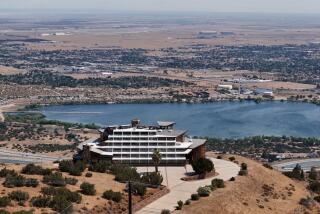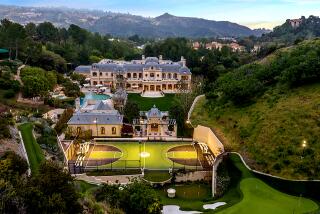Legendary Bel-Air estate Casa Encantada lists for the highest price in America: $225 million
- Share via
Is another record in the cards for Casa Encantada?
The Bel-Air home of financier Gary Winnick — a 40,000-square-foot 1930s-era trophy perched above the Bel-Air Country Club — has twice set the record for highest price of a residential real estate sale in the U.S.
Now, the storied estate is listing for sale at $225 million, making it the most expensive home publicly listed in the United States and a contender to unseat the current California recordholder for selling price: $119.75 million set this year when the former Spelling manor in Holmby Hills changed hands.
But the estate, graced with ionic columns and formal gardens, arrives on the market in the midst of a downturn.
After years of record trading, the high end has cooled this year. Single-family home sales on the Westside of Los Angeles are down about 16% year over year, while sales of $10 million and $20 million or more are down about 20% and 25%, respectively.
Overall, residential and multifamily sales across L.A. County have experienced an even greater dip.
As of September, there were 968 transactions of $5 million or more this year, down from 1,204 transactions during the same period last year, a drop of 19.6%, according to Zillow. Sales of $20 million or more have declined by more than two-thirds (109 transactions as of September 2019 versus 352 transactions during the same period in 2018).
One of the growing problems on the Westside: a market flooded with contemporary mansions built on speculation, with new ones entering the market each day, and a buyer pool that has remained static.
“It is not unusual to start seeing a glut of supply in any property type, mansions included, this late in an expansion cycle,” UCLA real estate professor Paul Habibi said. “Oftentimes [developers] have a herd mentality about introducing more inventory into the market.”
“The conventional wisdom is that so long as you’re not the last one without a seat when the music stops, you’ll make out OK,” he said.
Mark Atalla, managing partner of Irvine-based investment firm Carlyle Capital, believes that in the age of modern mansions, few stand out.
“Developers in some areas are overbuilding and overpricing,” Atalla said. “Those are the projects that are spending the most time on the market.”
Atalla said his company, which has a development project in Bel-Air, tends to stay away from the contemporary mansions, particularly in areas such as the Bird Streets, a celebrity-popular enclave in the Hollywood Hills, where the market has become oversaturated.
“A lot of developers are out of money, and they aren’t finishing projects,” Atalla said. “There’s construction that’s been sitting unfinished for two, three, four years in the Bird Steets because these guys are over-leveraged.”
Bel-Air and nearby Holmby Hills have seen their share of speculative development.
Roughly one mile north of Casa Encantada is the contemporary wonderland of handbag mogul Bruce Makowsky. The over-the-top mansion, which features a bowling alley and an ornamental helicopter, recently saw its price slashed to $150 million after debuting on the market in 2017 at a nation-high $250 million.
Looming on the horizon (and above the Bel-Air home of Jennifer Aniston) is another speculative pièce de résistance — a 100,000-square-foot residence developed by movie producer turned developer Nile Niami. Referred to as a “giga-mansion” because of its size, it is expected to hit the market with an unfathomable price tag of $500 million.
But among the very wealthy, real estate keeps moving, particularly when it comes to properties with pedigree, said Jeff Hyland, Casa Encantada’s listing agent with Beverly Hills-based Hilton & Hyland. Also sharing the listing is Rick Hilton, grandson of hotel magnate Conrad Hilton, a previous owner, and Shawn Elliott of Elite Real Estate Marketing.
“A classic home of this magnitude is in its own world,” Hyland said. “It’s not affected by market gyrations, world issues in the economy and other comparable estates.”
Habibi said that buyers will pay more for anything that is differentiated, whether it’s through design, location or another element unique to a property. “Differentiation allows for premium pricing,” he said.
Of L.A. County’s five sales of $100 million or more, four have historical or architectural significance, with the fifth — a 30,000-square-foot contemporary with multiple guesthouses and a theater complex — being built on the same two-plus-acre site in Holmby Hills where Barbra Streisand’s former “Mon Rêve” estate once stood.
The Spelling manor, for example, holds the current California price record after selling this year. The 56,500-square-foot trophy estate also has the distinction of being the largest single-family home in L.A. County and a size bigger than the White House.
The $100-million sale of the Playboy Mansion in 2016 was largely because of its location (Holmby Hills) and architectural pedigree — the former Gothic Tudor-style home of the late Hugh Hefner is considered among the finest works of Arthur R. Kelly.
The same can be said of the former Malibu homes of Hard Rock Cafe co-founder Peter Morton and NBCUniversal executive Ron Meyer. Both boasted designs by esteemed architects and sublime coastal locales, and both traded within the last two years in nine-figure deals.
Sitting behind an antique desk in the office of his home on a recent afternoon, Winnick wore a casual button-down shirt and jeans while he recounted the restoration of the home. Its craftsmanship is unrivaled, he said, and it’s hard to imagine someone offering a dissenting opinion.
The office itself, clad in rich walnut with steel-framed windows looking out on manicured gardens, is both a place of business and solace for the billionaire.
Winnick was founder and chairman of Global Crossing, which in the 1990s installed fiber-optic highways across the seafloor to create a global network connecting four continents and 27 countries.
He resigned prior to a reorganization of the company in 2002, the same year the telecommunications giant became one of the biggest U.S. firms ever to go bankrupt, part of the devastating bursting of the tech bubble.
Framed pictures of Winnick with world leaders and business elite are interspersed among floor-to-ceiling bookshelves. A portrait of George Washington, which Winnick believes was used on the dollar bill, sits above the fireplace; on a mantle across the room is a framed copy of the 12th Amendment of the U.S. Constitution, which in 1804 refined the electoral college process for picking the country’s president and vice president.
It’s the type of space that conjures visions of business titans completing deals over a conversation and a handshake — a scene somewhat reminiscent of how Winnick came to own the home in the first place.
Prior to buying Casa Encantada in 2000, Winnick had a different plan. The former Brentwood resident had purchased a number of nearby parcels with the intention of building his own estate.
However, at the invitation of then-owner David Murdock, he visited Casa Encantada and was struck by its magnificence. Murdock and Winnick would later work out a deal for the estate over breakfast at the home.
The story of Casa Encantada traces back to the 1930s, when the widow of a multimillionaire glass manufacturer commissioned architect James E. Dolena to design the grand estate, according to the book “The Legendary Estates of Beverly Hills.”
Dolena, whose clients included Hollywood luminaries William Powell and Joan Bennett, was considered a master of the traditional Georgian architecture, often integrating influences drawn from Art Deco and Moderne styles.
Peterson Studios and T.H. Robsjohn-Gibbons, the latter being America’s preeminent interior designer in the 1930s and ’40s, were hired to create custom-made furniture, carpets and fabrics for the home. No expense was deemed too great and, ultimately, no expense was spared — the mansion was completed in 1937, during the twilight of the Great Depression, at a cost of more than $2 million (that’s more than $35 million when adjusted for inflation).
In 1950, the estate was purchased by Conrad Hilton for $225,000 — a deal that included the furniture, art and silver. During his ownership, which spanned nearly three decades as Hilton grew his hotel chain into a global brand, Hilton made almost no changes to the home or its grounds. Following his death in 1979, it was purchased by Murdoch for $12.4 million, a U.S. record at the time.
Like many homes with generational ownership, Casa Encantada was in need of renovation when Winnick purchased it in 2000. He hired noted architect Peter Marino to handle the restoration and poured millions into the project, which took more than two years to complete.
The home’s systems were updated and artisans were brought in to re-create and renew its classic details. The walls and ceilings were hand-plastered by master craftsmen.
It’s because of a pedigree of craftsmanship spanning decades that Casa Encantada is considered irreplicable, Hyland said.
Although the exterior evokes Georgian with a broad, symmetrical front and four ionic columns supporting a massive portico, the interior is strongly influenced by the decadent Moderne style that grew from the Art Deco movement in the 1930s.
Wood-paneled walls and moldings are embellished with delicate clamshell and geometric patterns. A graceful entry with 18-foot ceilings gives way to a reception hall and grand formal rooms. In the den/card room, a decadent oval bar shimmering in sterling silver anchors one wall. A second bar lies in the pool house, which has a professional screening room.
The home’s H-shaped design allows for city, mountain and ocean views from nearly all of its 60 rooms.
Terrace balconies adorned in lace-like wrought ironwork extend from the home’s second story. A lighted tennis court, a basketball court, a pool, a guesthouse, greenhouses, koi ponds, a rose garden and a manager’s quarters are spread throughout the eight-plus-acre property.
Groves of mature trees and foliage make it invisible from the street and the fairways of the golf course that surround it.
“Could we duplicate this house today? Absolutely not,” Hyland said. “You couldn’t find the craftsmen; they’re all dead.”
One also couldn’t build something to the size and scale of Casa Encantada for its price.
Hyland believes Casa Encantada is worth about $175 million in land value alone. “Land in Bel-Air is trading at about $20 million an acre,” he said. Couple that with building costs in the range of $2,000 to $3,000 a square foot and the total cost would be sky-high.
Two miles west of Casa Encantada, cresting an eight-acre prominence on Chalon Road, is a gargantuan mansion being built for Qatar’s Al Thani royal family.
The Qatari estate centers on a 77,000-square-foot home designed by Peter Marino, the same architect who restored Casa Encantada. Its construction costs are well north of $300 million, according to people not authorized to comment publicly about the project.
Wealth-X, a website that produces an annual census of the world’s billionaires, reported that the billionaire population globally in 2018 was a little over 2,600, with 892 of those residing in the Americas. The United States alone accounts for 705 of the world’s billionaires, whose combined wealth totals north of $3 trillion.
The Casa Encantada buyer probably will come from that rarified pool, but Hyland believes that it won’t be someone of new money who ultimately purchases the estate.
“We don’t expect it to be someone who just made their money in tech on an IPO and is 29 years old,” he said. “It’s going to be someone who is sophisticated, someone who is a world traveler, who has homes in other places around the world.”
Still, at the end of the day, “it’s just a matter of zeros,” he said.
More to Read
Sign up for Essential California
The most important California stories and recommendations in your inbox every morning.
You may occasionally receive promotional content from the Los Angeles Times.







